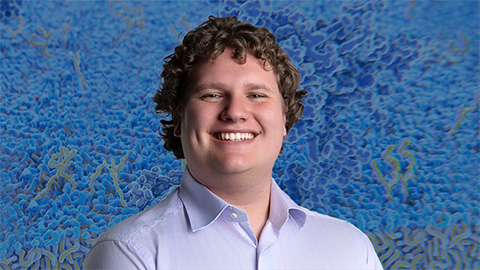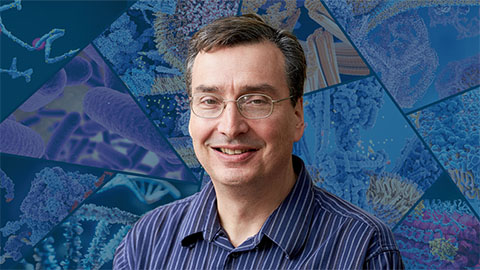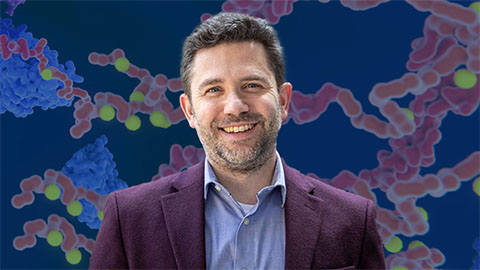Charles O. Rock (1949 – 2023)
Charles “Chuck” Owen Rock was a world expert in membrane lipid homeostasis in Escherichia coli and Staphylococcus aureus. For 43 years, he ran a prolific research program in the biochemistry department at St. Jude Children’s Research Hospital. He died unexpectedly on September 22, 2023, at the age of 73 in Bartlett, Tennessee.
I was fortunate to join the Rock Lab in 2018 with his final class of postdoctoral acolytes. He had high expectations, and our training included extensive planning meetings to refine hypotheses with definitive experiments.

Rock was born December 23, 1949, in Baltimore and graduated from Colorado State University in 1971 with a degree in zoology. He earned a Ph.D. in lipid biochemistry in 1976 from the University of Tennessee at Oak Ridge and spent a year at Oak Ridge National Laboratory before starting a postdoc at Yale University under the mentorship of lipid metabolism expert John Cronan. When Cronan moved his lab to the University of Illinois in 1979, Rock went with him, working as a research associate until the opportunity arose to establish a lab at St. Jude.
He was primarily interested in understanding the mechanisms of biochemical processes, and his research connected many disciplines, including biochemistry, structural biology, bacteriology and chemical biology. His most cited primary research is a 2001 paper in the Journal of Biological Chemistry about the molecular mechanism of two natural products, thiolactomycin and cerulenin, which inhibit key condensing enzymes that regulate bacterial fatty acid synthesis, or FASII. Another highly cited JBC paper validated FASII inhibition as an antibacterial mechanism for polyphenols and green tea extracts.
Rock’s pioneering work at St. Jude enabled the development of afabicin, a first-in-class narrow-spectrum anti-staphylococcal antibiotic that targets a FASII enzyme, and BBP-671, a first-in-class pantothenate kinase activator to treat organic acidemia and ultrarare pantothenate-kinase associated neurodegeneration, which iscurrently untreatable; both are now in clinical trials. Pantothenate kinase is the first enzyme in the coenzyme A biosynthetic pathway, and coenzyme A is an essential cofactor in all organisms that supports fatty acid metabolism and other processes.

A member of the American Society for Biochemistry and Molecular Biology since 1983, Rock was engaged with the ASBMB lipid community; he served as a member of the Lipid Research Division steering committee and on the JBC editorial board.
Over the course of Rock’s tenure, St. Jude had five CEOs. The biochemistry department was dissolved, and he moved to the infectious diseases department (now host-microbe interactions). He served on 31 institutional committees and was the project manager for construction of the Danny Thomas Research Center where his program resided. He received 31 competitive grants, published more than 300 papers and had more than 25,000 citations. He was elected a fellow in the American Academy of Microbiology and the American Association for the Advancement of Science.
Rock-isms and family
Rock loved St. Jude and continually reminded his trainees about the importance of the hospital’s mission. The quintessential St. Jude citizen, he took on hard, unenviable jobs such as institutional research integrity officer — the scientific top cop who investigates cases of scientific misconduct.
He also loved Memphis. He often spoke about the PGA Tour FedEx St. Jude Golf Championship, his fervent support of the NBA Memphis Grizzlies and Memphis University Tigers, and enjoying Memphis cuisine. Fittingly, for many years his office overlooked the iconic Memphis Pyramid and the Mississippi River.
Even with all his other obligations, meeting regularly with trainees was a priority, and Rock always made time for us. He shared his wisdom through analogies and adages we called Rock-isms, and there seemed to be a Rock-ism for every situation. Whether it was about “how the sausage gets made” or “slicing the bologna,” we always had what we needed to “let the big dog hunt” and “cook with propane gas.”

Rock had a keen ability to multitask and often brought unrelated reading material to a seminar, at the end of which he would look up from what he was reading and ask the most insightful question. This shocked everyone in the room — they were convinced his mind was elsewhere. I was always among the shocked, even though I witnessed the phenomenon every month of our departmental seminar series.
Suzanne “Suzy” Jackowski Rock, Chuck’s wife, was also a researcher on the St. Jude faculty. In 2019, the Rocks hosted a joint baby shower for several lab members, and since they were also expecting their granddaughter Savannah, we simultaneously welcomed babies into our lives. Rock enjoyed talking about baby progress and encouraged us through the challenges of first-time parenthood.
The Rock Lab was diverse in culture, geographic origin, age, gender, experience and wealth, but we all related to the importance of family. Through our conversations, we learned that our PI coached his son Andrew’s grade school soccer team and that young Andrew’s encounter with a hard-to-treat infection motivated Rock’s scientific interest in S. aureus pathogenesis.
Chuck Rock left a legacy of service, mentorship, collaboration, and rigorous science that advances our understanding of lipid metabolism and novel therapeutics. He is survived by his wife Suzy, sister Jane, son Andrew, granddaughter Savannah and a legion of dedicated protégés who are grateful for the time we had with him.
Remembrances from St. Jude
I remember the day that Chuck and I celebrated submitting our LAST NIH grants! We were finally free! We shared lots of chuckles about our days of stress, especially opening the email with the potentially deadly score and scrambling to figure out if we did or did not beat the payline.
Of course, Chuck was always in the single digits, so it was really no stress for him. Putting in the last one, though, really brought it home to us both that the job had now changed, and we were here to focus on helping the youngsters.
One of his greatest assets was his love of mentoring and I am truly sorry for the trainees that will miss out on this special educator.
—Elaine Tuomanen, member of the host-microbe interactions department and Rock’s former departmental chair
Once, I found myself engrossed in a discussion with Chuck about some experimental data that we found perplexing. Our focus centered on unraveling the complexities of a metabolic pathway pivotal for understanding pathogenic infections. Amidst the analysis and discussion, our attention was drawn to experimental data hinting at the bacteria's utilization of a specific pathway to salvage a mere molecule of ATP.
Skepticism lingered in my mind regarding such a seemingly marginal alteration having such a large role in bacterial success during infection. However, Chuck, freshly returned from an African safari, regaled me with vivid accounts of life teetering on the brink amid the unforgiving rhythms of predator and prey. His narrative painted a stark picture of survival in the savannah, where each moment was a battle for existence.
Through his tales, he illuminated the fundamental truth that in the relentless pursuit of survival, even the slightest disparities hold the power to tip the scales. He emphasized the significance of how minor biochemical intricacies can wield a disproportionate influence on broader outcomes. His profound understanding, coupled with an unwavering focus on the broader context, rendered him an invaluable colleague whose influence and legacy will continue to live on.
—Jason Rosch, associate member of the host-microbe interactions department and close collaborator
In 2015, Chuck came to visit me; as determined as ever, he wanted another go at drugging PANK, a target he had first discovered with Suzanne Jackowski as the enzyme responsible for the first dedicated and rate-limiting step in coenzyme A biosynthesis many years ago.
Over a few hours, we hatched a new strategy to discover PANK modulators. He found an extra pair of hands to work on the chemistry for me, and we launched the plan. This program went on to generate a clinical candidate PANK modulator, BBP671, and multiple backups in four intense and very rewarding years. It was an academic purple patch, which we both enjoyed.
He was always laser-focused, loved his lipid biochemistry and was an inspiration to be around.
—Richard Lee, member of the chemical biology and therapeutics department and long-time colleague
Chuck was a colleague, friend, and mentor who was always willing to lend a helping hand to anyone. More than that, Chuck was part of the very fabric of St. Jude and his legacy reflects his heartfelt commitment to rigorous science, collaboration, mentorship and mission-driven institutional service.
—James Downing, St. Jude president and CEO
Enjoy reading ASBMB Today?
Become a member to receive the print edition four times a year and the digital edition monthly.
Learn moreGet the latest from ASBMB Today
Enter your email address, and we’ll send you a weekly email with recent articles, interviews and more.
Latest in People
People highlights or most popular articles

Designing life’s building blocks with AI
Tanja Kortemme, a professor at the University of California, San Francisco, will discuss her research using computational biology to engineer proteins at the 2026 ASBMB Annual Meeting.

Jordahl named Gilliam Fellow
He will receive three years of funding to support his thesis research.

Bibel named assistant professor
She began her position at Loyola Marymount University in August 2025.

Unraveling the language of histones
Philip Cole presented his research on how posttranslational modifications to histones are involved in gene expression and how these modifications could be therapeutically targeted to treat diseases like cancer.

Cotruvo named Blavatnik award finalist
He received a $15,000 prize and was honored at a gala in October.

Phosphatases and pupils: A dual legacy
Yale professor Anton Bennett explores how protein tyrosine phosphatases shape disease, while building a legacy of mentorship that expands opportunity and fuels discovery in biochemistry and molecular biology.

